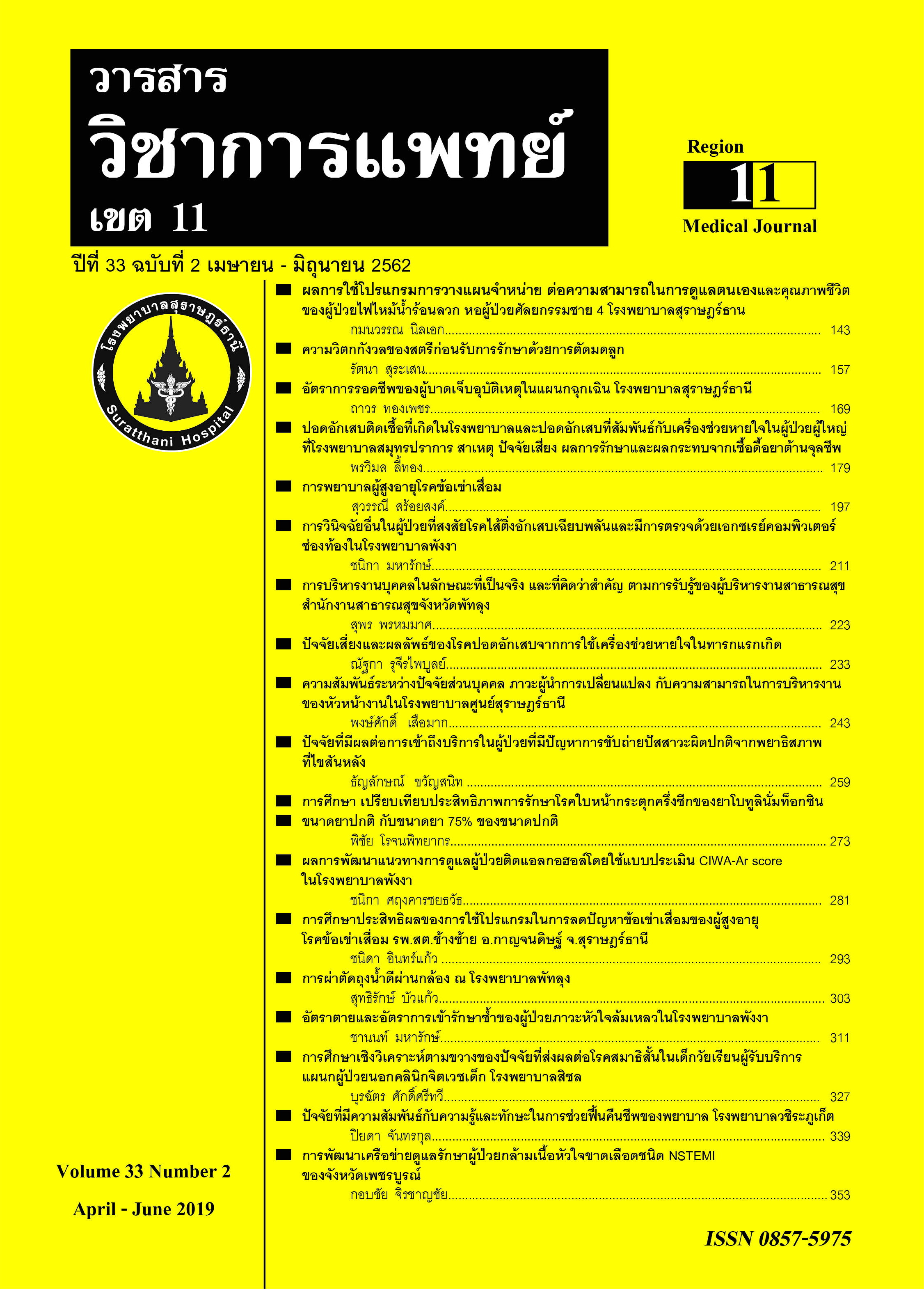Effectiveness of the program to reduce knee pain in osteoarthritis elderly patients in Chang-sai health promotion hospital
Keywords:
Knee osteoarthritis, effectiveness, knee pain reducingprogram, elderlyAbstract
Background: Elderly patients have high prevalence of knee osteoarthritis which the severity of the disease can effect on their function and well-being. Health personnel can help promote and prevent this deterioration by educating the patient.
Objective: This pre-experimental research aimed to study the effectiveness of the program to reduce knee pain in osteoarthritis elderly patients in Chang-sai health promotion hospital.
Method: Thirty patient with osteoarthritis were participated in this study. Clinical outcomes which were knee pain and severity of osteoarthritis between pre-test and post-test groups to evaluate the effectiveness of the programme. Research instruments included 1) knee pain reducing program 2) brochures for knee exercise, and 3) health record form. Demographic data and health status were collected during 25th Jan – 22nd Feb 2019. Data were analyzed by frequencies, percentages, mean, standard deviation and dependent t-test .
Result: Participant reported significantly reducing of pain score after the program, pre-test 5.16 to post-test 3.10 respectively (p-value<0.001). In moderate severity group of osteoarthritis, the severity was reducing from 23.30% to 6.70% after participated in the program.
Conclusion: Knee pain reducing program could reduce pain score and severity of osteoarthritis in elderly patients. This program may benefit by alternatively applying in clinical practice to reduce the pain and the severity of knee osteoarthritis.
References
2. สมาคมรูมาติสซั่มแห่งประเทศไทย. แนวทางเวชปฏิบัติการรักษาโรคข้อเข่าเสื่อม. ม.ป.ท ; 2554.
3. Felson, D. T., Lawrence, R. C., Dieppe, P. A., Hirsch, R., Helmick, C. G., Jordan, J. M., et al. Osteoarthritis: New Insights Part 1: The disease and its risk factors.
Annals of internal Medicine. [Internet]. 2000 [cited 2018 Jun 15]:1-2 .Available from: http://www.annals.org/cgi/reprint/133/8/635.pdf
4. World Health Organization. The burden of musculoskeleton conditions at the start of the newmillenium. [Internet]. 2003[cited 2018 Jun 15]:1-2. Available from : http://whqlibdoc.who.int/trs/WHO_TRS_919.pdf
5. Sun, J., Gooch, K., Svenson, L. W., Bell,N. R., & Frank, C. Estimating osteoarthritis incidence from population-based administrative. Annals epidermal 2007;17:1-56.
6. Cecchi F, et al. Epidemiology of hip and knee pain in a community based sample of Italian persons aged 65 and older. Osteoarthritis Cartilage2008;16:1039-46.
7. กระทรวงสาธารณสุข. สำนักนโยบายและยุทธศาสตร์ ข้อมูลสถิติ. [อินเตอร์เน็ต].2552 [เข้าถึงเมื่อ 15 มิถุนายน 2561].เข้าถึงได้จาก : http://bps. mop.go.th
8. งานเวชระเบียนและสถิติโรงพยาบาลสุราษฏร์ธานี. รายงานสถิติประจำปี. หน่วยเวชระเบียน: จังหวัดสุราษฏร์ธานี; 2551-53.
9. โรงพยาบาลส่งเสริมสุขภาพตำบลช้างซ้าย.รายงานสถิติการคัดกรองข้อเข่าเสื่อมของโรงพยาบาลส่งเสริมสุขภาพตำบลช้างซ้าย: สุราษฎร์ธานี; 2560.
10. วรรณีสัตย์วิวัฒน์. การพยาบาลผู้ป่วยออร์โธปิดิกส์. พิมพ์ครั้งที่6. กรุงเทพฯ:เอ็นพีเพรส; 2551.
11. มูลนิธิทศวรรษโรคกระดูกและข้อ. โรคข้อเข่าเสื่อม. [อินเตอร์เน็ต]. 2549 [เข้าถึงเมื่อ15 มิถุนายน 2561]. เข้าถึงได้จาก :http://www.boneandjointdecade.or.th/brochure.shtml
12. สำนักงานกองทุนสนับสนุนการสร้างเสริมสุขภาพ. พบผู้สูงอายุไทย 4 ล้านคน ป่วยโรคข้อเสื่อม. [อินเตอร์เน็ต]. 2555 [เข้าถึงเมื่อ15มิถุนายน2561]. เข้าถึงได้จาก:http://www.thaihealth.or.th/Content/3567
13. สุชิตา ปักสังคเน และคณะ.การประยุกต์ใช้ทฤษฏีการดูแลตนเองต่อการลดความเจ็บปวดและความพึงพอใจของผู้สูงอายุข้อเข่าเสื่อม. วารสารวิจัย มข.2554; 16: 1-10
14. สุระเพ็ญ สุวรรณสว่าง. ผลของการใช้โปรแกรมการออกกำลังกล้ามเนื้อต้นขาต่อระดับความปวดของผู้ป่วยโรคข้อเข่าเสื่อมตามวัย [วิทยานิพนธ์ปริญญาพยาบาลศาสตร์มหาบัณฑิต]. นครศรี
ธรรมราช:มหาวิทยาลัยวลัยลักษณ์;2551.






